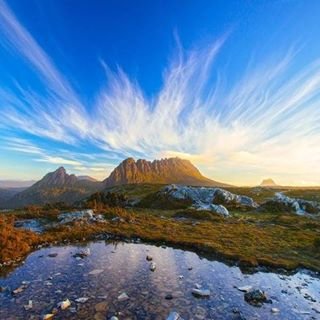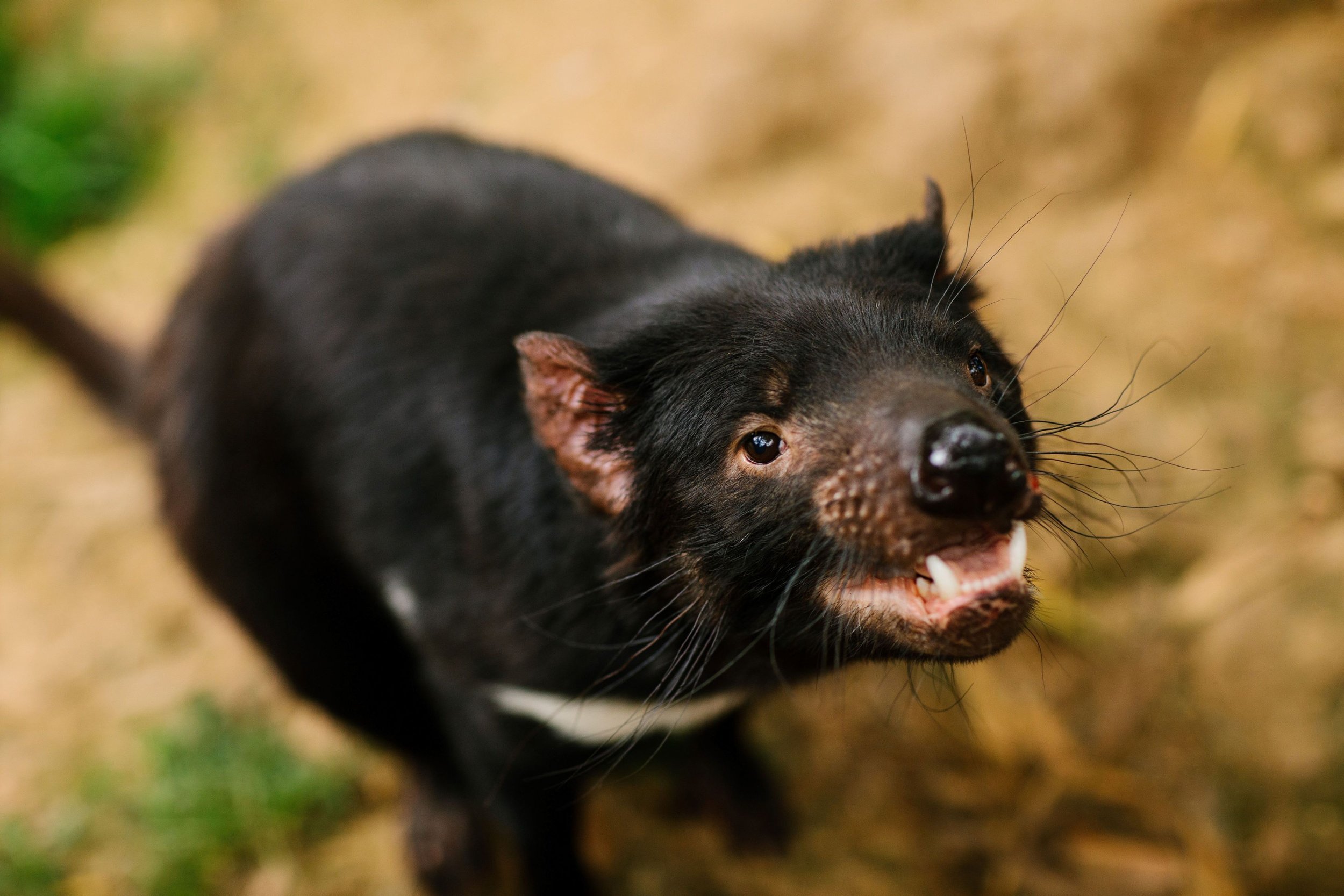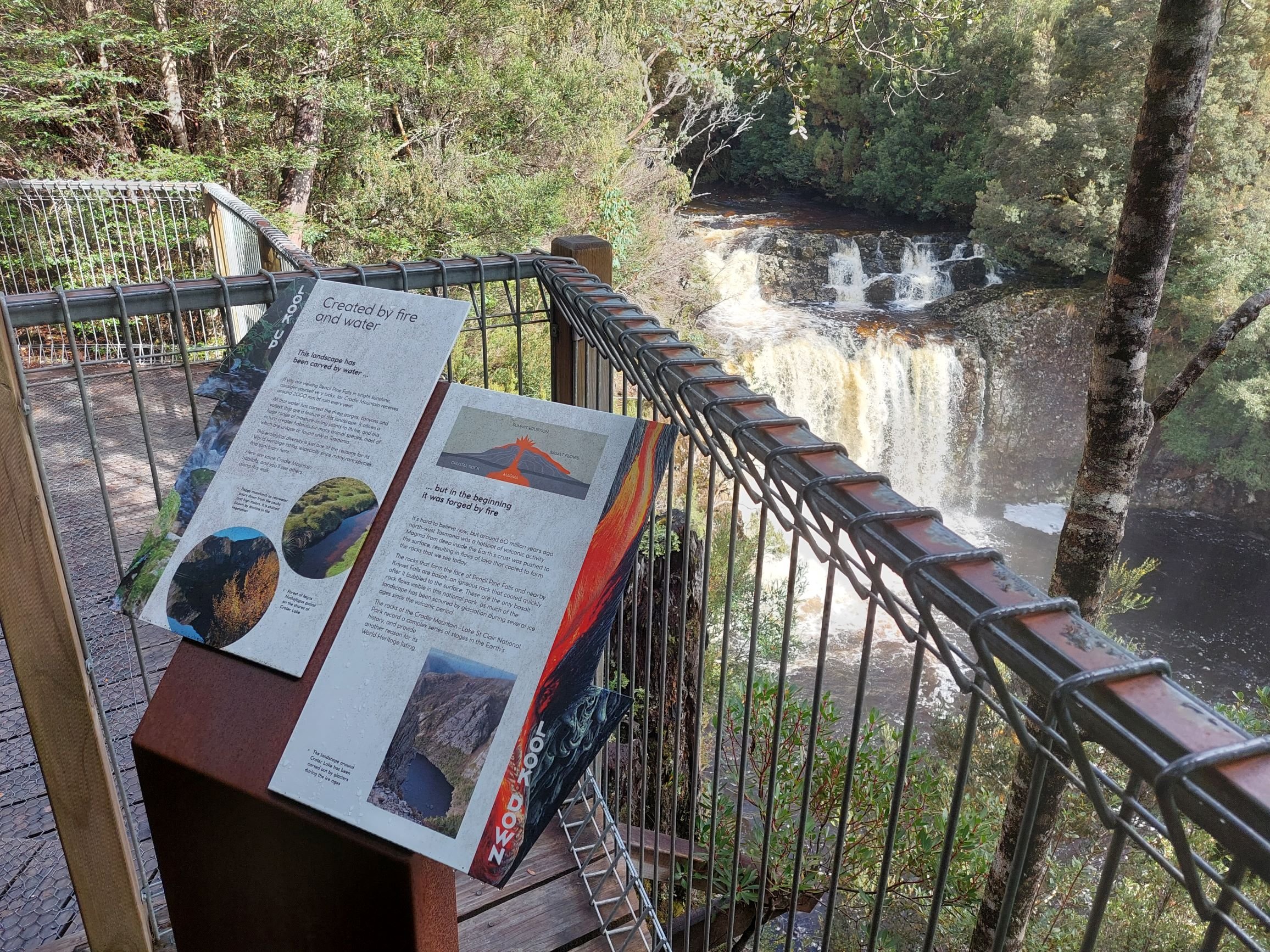Experience Cradle Mountain at your own pace with our excellent-value self-guided day tours from Launceston and Devonport using our Overland Track Shuttle service. Departing early in the morning and returning in the afternoon, these tours give you plenty of time to explore Dove Lake, walk the scenic trails, and enjoy the natural beauty of this iconic destination—without the rush and on your own terms.
Cradle Mountain Self Guide Day Tour from Launceston
Join us for a self-guided Cradle Mountain adventure departing from Launceston. You'll have plenty of time to explore iconic Dove Lake, and enjoy peaceful walks through the alpine landscape. We’ll drop you off at the Cradle Mountain Visitor Centre, where you can take the National Park shuttle to reach Dove Lake. Depart Launceston in the early morning with return to Launceston around 5 PM. (National Park entry is not included.)
Book two shuttles:
Launceston to Cradle Mountain
Cradle Mountain to Launceston
If your date is not showing contact david@eGuide.com.au
Cradle Mountain Self Guided Day Tour from Devonport
Join us for a self-guided Cradle Mountain adventure departing from Devonport. This flexible day trip gives you the freedom to explore at your own pace—stroll around the stunning Dove Lake, take in the mountain views, and enjoy the serenity of Tasmania’s alpine wilderness. You'll be dropped off at the Cradle Mountain Visitor Centre, where you can catch the National Park shuttle to reach Dove Lake.
Depart Devonport early morning and return around 4 PM. (Please note: National Park entry and shuttle bus fees are not included.)
Book two shuttles:
Devonport to Cradle Mountain
Cradle Mountain to Devonport
If your date is not showing contact david@eGuide.com.au
Cradle Mountain from Launceston staying one or more nights
Experience Cradle Mountain your way with our flexible overnight tour from Launceston. Stay for as many days as you like—whether it’s one night or a longer escape—and immerse yourself in the beauty of Tasmania’s alpine wilderness. Explore Dove Lake, hike the stunning trails, and unwind in the peaceful mountain atmosphere.
We’ll take you there and bring you back on the day of your choice, giving you complete freedom to enjoy Cradle Mountain at your own pace. Accommodation can be arranged or booked independently to suit your style and budget.
Book two shuttles:
Launceston to Cradle Mountain
Cradle Mountain to Launceston
Cradle Mountain from Devonport staying one or more nights
Enjoy the freedom to explore Cradle Mountain at your own pace with our flexible overnight tour from Devonport. Stay for as many nights as you like—whether it’s a short getaway or an extended alpine escape—and discover the beauty of Tasmania’s highland wilderness on your own terms.
Wander around Dove Lake, tackle scenic trails, and soak in the mountain serenity. We’ll drop you off and return to collect you on the day you choose. Accommodation is self-booked, giving you the flexibility to stay wherever suits you best.
Book two shuttles:
Devonport to Cradle Mountain
Cradle Mountain to Devonport
If your date is not showing contact david@eGuide.com.au
Some Cradle Mountain walks you can do.
Dove Lake Circuit: A popular 6-kilometre loop around the picturesque Dove Lake, offering stunning views of Cradle Mountain and the surrounding scenery.
Enchanted Walk: A shorter walk through ancient myrtle and beech forests, where you can experience the magic of the wilderness up close.
Cradle Valley Boardwalk: An easy stroll along a raised boardwalk through lush rainforest, with interpretive signs highlighting the area's flora and fauna.
King Billy Track: A scenic walk through sub-alpine woodland, featuring stands of ancient King Billy pines and glimpses of Cradle Mountain.
Lake Lilla Walk: A tranquil walk to the serene Lake Lilla, surrounded by towering eucalyptus trees and offering opportunities for picnicking and birdwatching.
Weindorfers Forest Walk: A peaceful walk through a forest planted by Gustav and Kate Weindorfer, early pioneers of Cradle Mountain conservation.
Knyvet Falls Track: A moderate walk to Knyvet Falls, where you can admire the cascading waterfall and lush vegetation along the way.
Pencil Pine Falls and Rainforest Walk: A short walk to Pencil Pine Falls, passing through ancient rainforest filled with moss-covered trees and ferns.
Ronny Creek to Dove Lake Walk: A scenic walk from Ronny Creek to Dove Lake, offering varied terrain and breathtaking views of Cradle Mountain.
Cradle Mountain
For more than 35,000 years, Tasmanian Aboriginal people hunted game and collected food plants in the area that is now Cradle Mountain National Park. While archaeological findings suggest they did not live permanently in this alpine environment due to its challenging conditions, there is evidence that they regularly travelled through the sub-alpine valleys on seasonal hunting trips.
Several Aboriginal sites have been discovered in the area, including rock shelters and caves. There is also written evidence from early European settlers detailing the construction of bark huts by Indigenous peoples and the controlled burning of vegetation. Several sites within Cradle Mountain-Lake St Clair National Park carry enormous significance to the Tasmanian Aboriginal community and illustrate their ongoing connection to this cultural landscape.
In the 1820s, European explorers, graziers, hunters and prospectors began visiting the region. Cradle Mountain was named in 1827 by the English surveyor Joseph Fossey, who thought the peak resembled a cradle. Henry Hellyer was the first European to successfully summit the mountain in 1831. Shortly after, fur trappers began arriving, followed by timber getters in search of King Billy pines.
As early as the 1890s, tourists arrived to marvel at the natural beauty of this wilderness area. Influential in protecting the landscape were Austrian-born Gustav Weindorfer and his wife, Kate. The Weindorfers and their supporters campaigned to preserve the area and were rewarded for their efforts in 1922 when 63,943 hectares were set aside as a scenic reserve.
Cradle Mountain became a wildlife reserve in 1927 and was upgraded to a national park in 1947. In 1982, Cradle Mountain-Lake St Clair National Park was designated as part of the Tasmanian Wilderness World Heritage Area, alongside Franklin-Lower Gordon Wild Rivers National Park.
In 1912, Gustav and Kate Weindorfer built a rustic home, “Waldheim”, which was destroyed during a fire in 1976. A replica has since been built using bush carpentry techniques and shingles split from King Billy pine. It is accessible along the short Weindorfers Forest Walk, which departs from Ronny Creek.
Ronny Creek is also the departure point for Tasmania’s most famous hike, the Overland Track, which takes in some of the park’s most breathtaking wilderness areas. After 65 kilometres or roughly six days of walking, the track ends on the shores of beautiful Lake St. Clair at the southern end of the park. The Overland Track is considered the premier alpine walk in Australia and draws trekkers from across the globe. It takes in ancient rainforests, eucalypt forests and picturesque alpine meadows, with optional side trips leading to waterfalls and Tasmania’s highest peak, Mount Ossa.
In addition to its snow-capped peaks, sparkling glacial lakes and wild alpine moors, Cradle Mountain provides a habitat for a diverse range of native flora and fauna. A highlight of visiting the park is coming face-to-face with its native wildlife, including pademelons, echidnas and wombats. These short-legged marsupials can often be seen grazing around the Interpretation Centre, with dusk one of the best times to see them. Tasmanian devils and platypus also inhabit the park, although they are much more difficult to spot.
Due to its endemic avian species, Cradle Mountain National Park has been designated as an Important Bird Area. Bird watchers should keep their eyes peeled for green rosellas, pink robins and black currawongs, as well as yellow-tailed black cockatoos. Wedge-tailed eagles are also known to nest in the park’s cliffs.
Cradle Mountain is also special for its unique flora, with between 40 and 55 percent of its plant species only found in this region. This diversity is partly due to the lack of forest fires that have impacted neighbouring areas. Aside from alpine heaths and grasslands, you’ll discover ancient rainforests dominated by deciduous beech, myrtle, sassafras and King Billy pines. In summer and spring, the park’s wildflowers ignite in colour, with the waratahs, banksias and hakeas particularly impressive.
Spectacular views of Cradle Mountain are on offer from the shores of Dove Lake, which is the starting point for several walks in the park. Among the most popular is the Dove Lake Circuit Walk, which is six kilometres in length and can be completed in around two and a half hours. It hugs the shores of Dove Lake as it weaves between temperate rainforests and sub-alpine plant communities, with the jagged summit of Cradle Mountain a constant backdrop.
One of Dove Lake’s most iconic features is its boatshed, which was built in 1940 by the park’s first ranger, Lionel Connell. It once housed Huon pine boats that could be rented by tourists for leisurely paddles on the lake. While the boatshed was restored in the 1980s, it remains largely in its original form and provides a charming compositional feature for photographers.
Dove Lake also marks the start of the Crater Lake Circuit, which takes in alpine lakes and pandani forests on its way to a classic cirque lake. Gouged out by ice and glacial snow, it’s evidence of the geological forces that shaped the area. At just under six kilometres in length, the Crater Lake Circuit is a good alternative to the Dove Lake Circuit during the busy summer months.
For elevated views of Cradle Mountain, you can climb to Hanson’s Peak or tackle the 7.5-kilometre-long trail that leads to Marion’s Lookout. If you are attempting either of these walks, it’s important to be well-prepared for exposed and windy conditions at the top.
Several shorter walks depart from the Interpretation Centre, including the family-friendly Rainforest Walk. It can be completed in just 10 minutes and is accessible to wheelchair users. For something slightly longer, you can try the Enchanted Walk, with the first section of this walk also accessible by wheelchair. The Enchanted Walk takes in mossy myrtle forests and eucalypt woodlands and is a good place for spotting wombats.
If you want to get up close to majestic King Billy pines, you can follow the two-kilometre-long King Billy Track, which leads through an old-growth rainforest. The Interpretation Centre also marks the start of the Waterfall Walk, which takes in the picturesque cascades of Pencil Pine Falls and Knyvet Falls.
Connecting the Interpretation Centre and Dove Lake is the Cradle Valley Boardwalk, which winds its way through golden tussock grasslands and past Lake Lilla. It’s possible to walk only as far as Ronnie Creek along this boardwalk trail, then catch the shuttle the rest of the way.
Aside from its hiking trails and spectacular wilderness area, Cradle Mountain is home to several other attractions that are worth exploring.
At the entrance to Cradle Mountain National Park is Devils@Cradle, which is named after its most iconic resident, the Tasmanian devil. This popular wildlife sanctuary is also home to several other native species whose survival is at threat, including spotted-tail and eastern quolls. Devils@Cradle is a great place to learn about the conservation status of Tasmanian devils and the facial tumour disease that has impacted their populations. The sanctuary also runs tours after dark, which is when these nocturnal creatures are at their most active.
Art lovers shouldn’t miss the Cradle Mountain Wilderness Gallery, which celebrates the natural landscapes of Tasmania through changing exhibitions and installations. It features a room dedicated to the internationally celebrated photographer, Peter Dombrovskis, as well as an annual exhibition showcasing contemporary Tasmanian artists. You can watch iconic Tasmanian films in the movie room before picking up locally made arts, crafts and produce in the gift shop.
For a pampering experience, don’t miss the Waldheim Alpine Spa, which is surrounded by a magnificent stand of King Billy pines. Accompanied by the tranquil sound of a trickling mountain stream, you can enjoy therapeutic massages, as well as beauty treatments inspired by the wilderness setting.
On the edge of the park is the Cradle Mountain Interpretation Centre where you’ll find exhibits about the natural and cultural history of the area. You can chat with the friendly rangers about things to see and do at Cradle Mountain or just warm up beside the cosy fireplace after returning from your hike.
Once you’ve built up an appetite, there are plenty of places to dine in and around Cradle Mountain National Park, including a relaxed cafe at the Interpretation Centre that is open for lunch and snacks. At the Cradle Mountain Hotel, you can dine on seasonal fare in the Altitude Restaurant or head to Cradle Mountain Village’s Hellyers Restaurant, which specialises in locally sourced produce. Near the Interpretation Centre is Peppers Cradle Mountain Lodge, which boasts two restaurants. Bistro-style meals are served at the rustic Tavern Bar & Bistro while fine dining is the focus of the Highland Restaurant.









